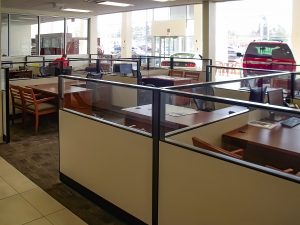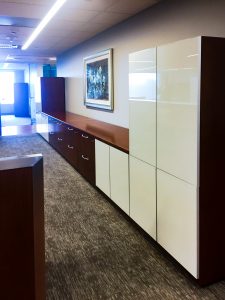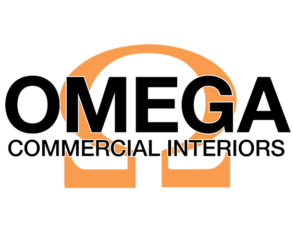A functional workstation is essential to the operational flow of a business. A workspace has the potential to be impressive, inviting and productive if the business allows a space planner to develop it. A space planner has the experience to foresee changes that eventually happen to a growing business and therefore, the business’s workstation has the potential to grow with the business. Here are some assessments that are implemented into a functional workstation.
Environment
 Adequate space, lighting and ventilation are necessary for a functional workstation. Floor plans are essential for planning electrical, voice, data and lighting needs as well as other concerns. It is important for the space planner to understand who does what, with whom, where and when. A layout of a traffic pattern of employees who must collaborate or physically interact with each other is very helpful to structure the new floor plan around the actual traffic patterns.
Adequate space, lighting and ventilation are necessary for a functional workstation. Floor plans are essential for planning electrical, voice, data and lighting needs as well as other concerns. It is important for the space planner to understand who does what, with whom, where and when. A layout of a traffic pattern of employees who must collaborate or physically interact with each other is very helpful to structure the new floor plan around the actual traffic patterns.
Utilization
 Consideration should be given to how the space is used. Is the space for collaborative, learning, interacting, focusing or a combination of these? Good workstations are inviting to both the employee and the guests that visit the workstations. There may be areas that need low- level privacy and allow for constant collaboration. High-level walls or sound insulated cubicles may be needed in other areas to provide partial privacy. Using cubicles, systems furniture or modular workstations allows for change in the future because the furniture can be placed into different arrangements.
Consideration should be given to how the space is used. Is the space for collaborative, learning, interacting, focusing or a combination of these? Good workstations are inviting to both the employee and the guests that visit the workstations. There may be areas that need low- level privacy and allow for constant collaboration. High-level walls or sound insulated cubicles may be needed in other areas to provide partial privacy. Using cubicles, systems furniture or modular workstations allows for change in the future because the furniture can be placed into different arrangements.
Workspace Components
 Proper arrangement of workspace components encourages employees to choose neutral body positions that promote better performance and increases efficiency in the work place. Certain features can be added to these components that make it easier for the employee to reduce tension and increase productivity. Some of these include the following:
Proper arrangement of workspace components encourages employees to choose neutral body positions that promote better performance and increases efficiency in the work place. Certain features can be added to these components that make it easier for the employee to reduce tension and increase productivity. Some of these include the following:
Desks
Well-designed desks can be appropriately adjusted for standing or sitting and provide adequate clearance for the legs and feet. They also allow room for proper placement of all computer components and accessories and minimize awkward postures and exertions from the user. Xsede has a popular adjustable height desk and is featured by Kimball Office Furniture. There are also other features that make this desk attractive like its power data beam that distributes power to multiple users cleanly.
Chairs
Chairs can be made to provide support to the user’s back, legs and arms reducing exposure to awkward postures as well. Quality chair features include but are not limited to the following:
Mesh back for ventilation
Adjustable/removable arms and adjustable arms height
Back tension adjustment
Back angle adjustments
3” seat cushion
5-point base
Adjustable back lumbar support
Seat height adjustment
Castors
Head rest for low backs
Kimball Office Furniture features a chair from Joya that meets all of the above.
Storage
 Storage areas should be easily accessible and ample so that employees can locate documents and items efficiently.
Storage areas should be easily accessible and ample so that employees can locate documents and items efficiently.
Keyboards, Pointer/Mouse devices and Palm Supports
Proper placement of computer peripherals will reduce back and neck strain on the computer user and therefore, increase worker productivity. Palm supports and footrests can also increase safety in the work place.
Monitors and Touch Screens
Monitors and touch screens can be mounted on adjustable height stands to provide better placement to reduce light glare and eye strain when the monitor is in use.
Telephones and Headsets
Consideration needs to be given to the placement of telephones so that the wires do not become tangled. Headsets should be provided when it is expected for the operator to answer calls while using the monitor.
Document Holders, Lamps and Bulletins
Other accessories like document holders, lamps and bulletins can be appropriately placed to help employees remain efficient throughout the workday as well. If these items are easily accessible, the employee will be more likely to use them effectively. Multi-purpose spaces by using materials like glass panel doors that double as dry erase boards. Implementing task lights reduces eyestrain, improves computer-based reading comfort reduces energy costs because overhead lights may not be necessary. Adjustable copyholders keep documents aligned to encourage low-risk posture while reading, editing and inputting data.

